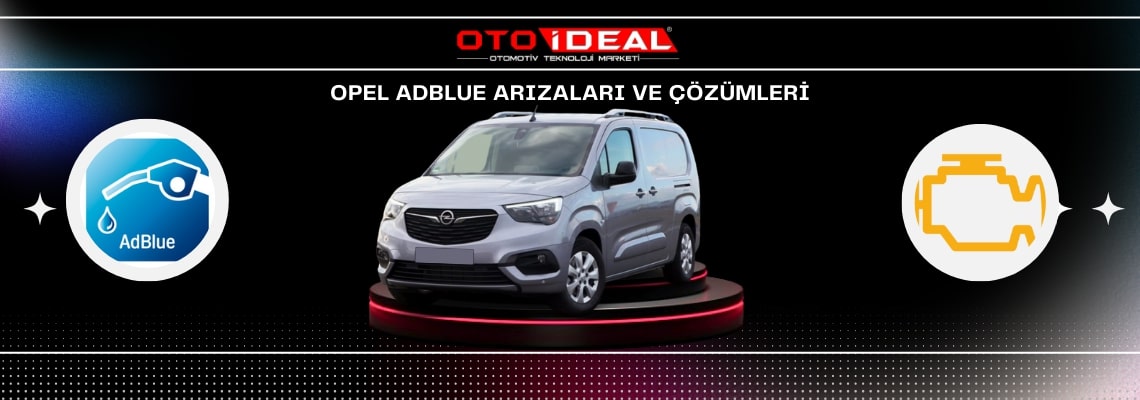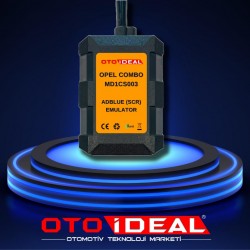
Issues and Solutions in Opel AdBlue System
Opel Astra, Insignia, Grandland X, Crossland X, Zafira Life, Combo, Vivaro and Movano models often show a “Check AdBlue System” warning, indicating an issue within the vehicle's emission control system. Why does AdBlue failure occur? Problems in the AdBlue system are typically caused by a reduction in AdBlue fluid levels, issues within the SCR (Selective Catalytic Reduction) system, or sensor failures. The first step is to check the AdBlue level and refill it if necessary. If the issue persists, use the Opel MDI 2 diagnostic tool to check error codes and identify the source of the problem. Addressing these issues early is crucial for maintaining your vehicle's long-term performance.
What to Do if the AdBlue Warning Light is On?
If the AdBlue warning light is on in your Opel model, it indicates a problem with the AdBlue system. Can AdBlue failure prevent the car from starting? Yes, a serious issue within the AdBlue system can prevent the vehicle from starting. Start by checking the AdBlue level and topping it up if needed. If the light continues to stay on, the quality of the AdBlue fluid may be the issue. Low-quality or old AdBlue fluid can prevent the system from functioning correctly. In this case, you may need to completely drain and refill the tank with fresh AdBlue. What does AdBlue system failure mean? This means there is a fault within your vehicle’s SCR system that requires immediate attention. Try resetting the system using a diagnostic tool. If the problem persists, a more comprehensive technical inspection may be necessary.
AdBlue Tank Full but Still Receiving Warning: Causes and Solutions
If you receive a warning even though the AdBlue tank is full, this typically indicates another issue within the system. Why do such AdBlue issues occur? Problems like low-quality AdBlue fluid, crystallization, or sensor malfunctions can trigger such warnings. The first step is to drain the existing fluid and refill the tank with fresh, high-quality AdBlue. If the warning persists, there may be a problem with the system's sensors or injectors. In this case, use the Opel MDI 2 tool to identify the faults and carry out the necessary repairs. How to resolve AdBlue problems? It may be necessary to replace or repair sensors or injectors. Ignoring such issues can negatively impact your vehicle's emission performance.
How to Reset the AdBlue System in Opel Vehicles
Resetting the AdBlue system in Opel vehicles may be necessary, especially if the AdBlue light remains on. How is the AdBlue reset procedure carried out? In Opel vehicles, the AdBlue system can be reset using the Opel MDI 2 diagnostic tool and the GDS (Global Diagnostic System) software. These tools are designed for diagnosing and repairing Opel vehicles.
Steps to Reset the AdBlue System with GDS
- Prepare the Opel MDI 2 Tool and GDS Software: Connect the tool to your computer and run the GDS software. Ensure the software is up-to-date.
- Connect the Vehicle: Connect the vehicle to the Opel MDI 2 tool via the OBDII port. This connection provides access to the vehicle's electronic control unit.
- Select the AdBlue System: In the GDS software, select the vehicle's AdBlue system and view existing faults.
- Initiate the Reset: Choose the "AdBlue Reset" option and follow the instructions. This process clears any errors and restores the normal operation of the AdBlue system.
- System Test: After completing the reset process, take the vehicle for a test drive to ensure the AdBlue system is functioning correctly. If the warning light reappears, a more detailed mechanical inspection may be required.
This process can help resolve existing issues within the AdBlue system and reset it. However, if the problem persists, professional service support may be necessary.
DPF Problems: Causes and Solutions
Opel models are equipped with a DPF (Diesel Particulate Filter) that captures harmful emissions, ensuring less harmful gases are released into the environment. Over time, however, this filter can become clogged, leading to DPF issues. Why does DPF clogging occur? The DPF typically becomes clogged due to short trips, the use of low-quality fuel, and insufficient maintenance. Short trips prevent the DPF from regenerating (self-cleaning), which leads to the accumulation of particulates in the filter.
How to Resolve DPF Problems? The first step is to initiate the DPF regeneration process by driving the vehicle at high speed over a long distance. This process burns off accumulated particulates and cleans the DPF. If this method does not work, professional cleaning or replacement of the DPF may be necessary. Using the Opel MDI 2 tool to clear error codes and manually initiate regeneration may also be required. If the DPF is completely blocked and cannot be cleaned, the best solution is to have the filter cleaned or replaced.
EGR Problems: Causes and Solutions
Opel models are equipped with an EGR (Exhaust Gas Recirculation) valve, which helps reduce emissions by redirecting some exhaust gases back into the combustion chamber. Over time, however, the EGR valve can become clogged with carbon deposits, leading to failures. Why do EGR problems occur? Low-quality fuel, frequent short trips, and a lack of regular maintenance cause the valve to become clogged with carbon.
How to Resolve EGR Problems? The first step may involve cleaning the EGR valve. A carbon cleaning process removes deposits from the EGR valve, allowing it to function properly again. If the valve is severely clogged or damaged, it may need to be replaced. Use the Opel MDI 2 tool to check for error codes and assess the condition of the EGR valve. Proper EGR system function is critical for controlling your vehicle's emissions, so addressing failures promptly is important.
AdBlue, DPF, and EGR Error Codes in Opel Vehicles
In Opel vehicles, the following are common error codes related to the AdBlue, DPF (Diesel Particulate Filter), and EGR (Exhaust Gas Recirculation) systems:
AdBlue-Related Error Codes
- P20E8: AdBlue pressure low
- P20F6: AdBlue level sensor fault
- P2033: AdBlue heater fault
- P2047: AdBlue injector circuit fault
- P207F: SCR system efficiency low
- P2200: NOx sensor circuit fault (pre-sensor)
- P2202: NOx sensor circuit low (pre-sensor)
DPF-Related Error Codes
- P2002: DPF efficiency low (particulate filter clogged)
- P242F: DPF overloaded
- P2453: DPF pressure sensor fault
- P2458: DPF regeneration duration too long
- P2463: DPF excessive particulate accumulation
EGR-Related Error Codes
- P0400: EGR flow fault
- P0401: EGR flow insufficient
- P0402: EGR flow excessive
- P0403: EGR valve circuit fault
- P0404: EGR valve fault
- P0405: EGR sensor circuit low
- P0406: EGR sensor circuit high
These error codes indicate a problem within the vehicle's emission control systems and can typically be identified using diagnostic tools like the Opel MDI 2 device. Each code indicates a specific issue within a component or system, helping the vehicle owner or technician identify the source of the problem.


-75x75w.jpg)


-75x75w.jpg)










-75x75.jpg)





-75x75w.png)



Leave a Comment